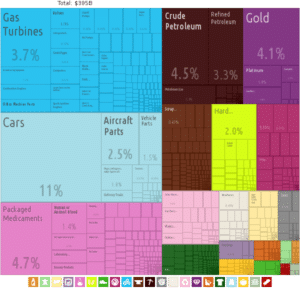

Wales accounts for less than one-tenth (9 per cent) of the total area of the UK, covering 20,779 square kilometers (8,020 sq mi). Wales is mostly mountainous, though South Wales is less mountainous than North and mid Wales. The main population and industrial areas are in South Wales, consisting of the coastal cities of Cardiff, Swansea and Newport, and the South Wales Valleys to their north. The highest mountains in Wales are in Snowdonia and include Snowdon which, at 1,085 meters (3,560 ft), is the highest peak in Wales. Wales has over 2,704 kilometers (1,680 miles) of coastline. Several islands lie off the Welsh mainland, the largest of which is Anglesey in the north-west.
Northern Ireland, separated from Great Britain by the Irish Sea and North Channel, has an area of 14,160 square kilometers (5,470 sq mi) and is mostly hilly. It includes Lough Neagh which, at 388 square kilometers (150 sq mi), is the largest lake in the British Isles by area. The highest peak in Northern Ireland is Slieve Donard in the Mourne Mountains at 852 metres (2,795 ft).

The UK has a partially regulated market economy. Based on market exchange rates, the UK is today the fifth-largest economy in the world and the second-largest in Europe after Germany. HM Treasury, led by the Chancellor of the Exchequer, is responsible for developing and executing the government’s public finance policy and economic policy. The Bank of England is the UK’s central bank and is responsible for issuing notes and coins in the nation’s currency, the pound sterling. Banks in Scotland and Northern Ireland retain the right to issue their own notes, subject to retaining enough Bank of England notes in reserve to cover their issue. The pound sterling is the world’s third-largest reserve currency (after the US dollar and the euro). Since 1997 the Bank of England’s Monetary Policy Committee, headed by the Governor of the Bank of England, has been responsible for setting interest rates at the level necessary to achieve the overall inflation target for the economy that is set by the Chancellor each year.
The UK service sector makes up around 79 per cent of GDP. London is one of the world’s largest financial centers, ranking 2nd in the world, behind New York City, in the Global Financial Centres Index in 2020. London also has the largest city GDP in Europe. Edinburgh ranks 17th in the world, and 6th in Western Europe in the Global Financial Centres Index in 2020. Tourism is very important to the British economy; with over 27 million tourists arriving in 2004, the United Kingdom is ranked as the sixth major tourist destination in the world and London has the most international visitors of any city in the world. The creative industries accounted for 7 per cent GVA in 2005 and grew at an average of 6 per cent per annum between 1997 and 2005.

Following the United Kingdom’s withdrawal from the European Union, the functioning of the UK internal economic market is enshrined by the United Kingdom Internal Market Act 2020 which ensures trade in goods and services continues without internal barriers across the four countries of the United Kingdom.